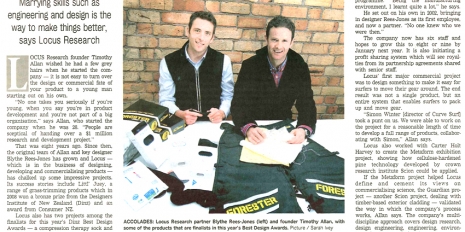
Locus Research featured in the Success feature of the New Zealand business herald article by journalist Yoke Har lee. The article is reproduced here but can be found on the NZ business Herald site
Marrying skills such as engineering and design is the way to make things better, says Locus Research.
Locus Research founder Timothy Allan wished he had a few grey hairs when he started the company - it is not easy to turn over the design or commercial fate of your product to a young man starting out on his own.
"No one takes you seriously if you're young, when you say you're in product development and you're not part of a big organisation," says Allan, who started the company when he was 28. "People are sceptical of handing over a $1 million research and development project."
That was eight years ago. Since then, the original team of Allan and key designer Blythe Rees-Jones has grown and Locus - which is in the business of designing, developing and commercialising products - has chalked up some impressive projects. Its success stories include Littl' Juey, a range of grass-trimming products which in 2008 won a bronze prize from the Designers Institute of New Zealand (Dinz) and an award from Consumer NZ.
Locus also has two projects among the finalists for this year's Dinz Best Design Awards - a compression therapy sock and protective clothing for for chainsaw users.
The accolades endorse the company's philosophy of product development and design.
"I don't think anyone else approaches design the way we do. It took us a long time to build the capability," he says, noting that traditionally design houses are called in to do design and branding, whereas product development for companies trying to commercialise new ideas usually rests in the domain of the engineering department.
An industrial designer by training, Allan is not entirely convinced that industrial design alone is enough. "There are many facets to commercialising a product. You need a blend of the quantitative side of engineering and the qualitative side of design."
Locus works on the basis that it can help clients derive more value from their products by marrying all the aspects needed to make a product succeed: R&D, design, branding, packaging, communication and effective distribution channels.
The company's pricing structure builds in a potential future profit stream based on royalties from partnership projects.
In the end, says Allan, it is about the process, consistency, the ability to repeat that process and gain consistent results.
Allan himself was a lucky young upstart designer at bedmaker Design Mobel when founder Dave Macfarlane gave him full support in running the company's design programme. "Being the manufacturing environment, I learnt quite a lot," he says.
He set out on his own in 2002, bringing in designer Rees-Jones as its first employee, and now a partner. "No one knew who we were then."
The company now has six staff and hopes to grow this to eight or nine by January next year. It is also initiating a profit sharing system which will see royalties from its partnership agreements shared with senior staff.
Locus' first major commercial project was to design something to make it easy for surfers to move their gear around. The end result was not a single product, but an entire system that enables surfers to pack up and move gear.
"Simon Winter [director of Curve Surf] took a punt on us. We were able to work on the project for a reasonable length of time to develop a full range of products, collaborating with Simon," Allan says.
Locus also worked with Carter Holt Harvey to create the Metaform exhibition project, showing how cellulose-hardened pine technology developed by crown research institute Scion could be applied.
If the Metaform project helped Locus define and cement its views on commercialising science, the Guardian project - another Scion project, dealing with timber-based exterior cladding - validated the way in which the company's process works, Allan says. The company's multi-discipline approach covers design research, design engineering, engineering, environmental science and chemistry.
His advice to companies wanting to apply science to product development is to ensure the chief executive has full ownership of the project.
Locus also has developed intellectual property on how to manage a product's life cycle. Life cycle thinking, Allan says, is best described as putting on different lenses to look at a company's product and services that can often deliver insights into how a product should be designed and delivered.
"Rather than just environmental management, it is important if you understand what customers are doing with your product, how long your product will last, how it is put together and who will interact with it."